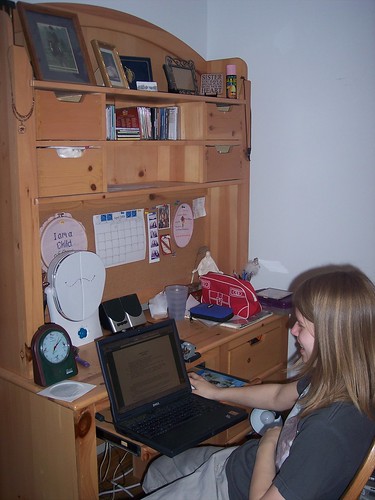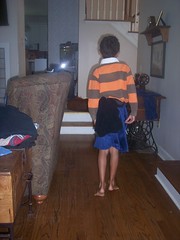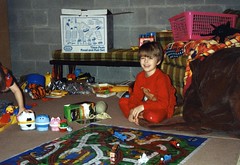In a comment on my blog, JoVE referenced this talk by Sir Ken Robinson that was recorded February, 2006. I would like to invite everyone to start by listening to his words with a point-of-reference geared toward the rant I shared here about giving value to our right-brained learners. Here is someone who fully “gets it”.
There were several poignant places in this speech, but one was after he described the process of how Gillian Lynne, the “Cats” choreographer, came to discover her talent. The public school she attended in the 1930s informed her mother that she was not fitting in well there, and maybe she has some problems that need to be checked out. Her mother took Gillian to a psychiatrist, and after a briefing, he asked the mother to leave with him out in the hallway while he left young Gillian in his office after he turned on the radio. They looked back into the room as they saw Gillian dancing around the office, and he looked at her mother and simply stated, “Your daughter is not sick, Mrs. Lynne; she’s a dancer. Put her in dance school.” The rest is history as she is reowned for her talent in dance and choreography.
Our right-brained learners are not sick; they are not broken; they are not a problem. Our right-brained learners are dancers; they are artists; they are musicians; they are actors; they are architects; they are video game programmers. This is who they are. To change that is at best to “squander away their talents”, to borrow the phrasing from Sir Robinson, and worse, to quote my oldest son upon hearing about my discussions here, would be to “psychologically destroy them”. I want neither for my amazing right-brainers!Does that mean they’re perfect the way they are? Of course not, as we all have our weak areas and difficulties. However, because of our conditioning in giving value to left-brained traits, we think the very traits that make them right-brained thinkers ARE the weak areas and difficulties. If we intervened in these areas for the sake that it goes against the grain of conditioned societal thinking, then we are changing who they are. So, how do we differentiate? For me, a loose definition would be that if something is impacting the quality of life for my child from his/her perspective or from my perspective filtered through my de-conditioning lens and based on wisdom or mother’s intuition, then I might seek to help my child develop skills and strategies that will benefit him/her.
From my experience, there is very little in the learning/education department that needed my help. Most of the help needed in this arena fell on my shoulders for myself. I needed to become educated about learning styles. (In my day, In Their Own Way, by Thomas Armstrong was my foundation. Nowadays, there are scads more!) I needed to question my conditioned reactions and responses to various methods and timeframes. (Again, in my day, Growing Without Schooling and the works of John Holt helped tremendously. Today, it’s called deschooling.) I found myself becoming intrigued and excited about what was unfolding before me through my children. (I call it becoming an anthropologist of sorts.) Some of the things I remember letting go of: Why not count on your fingers? Why do “show me work”? Why can’t learning happen orally? Why can’t the child have his core curriculum be dinosaurs? Why can’t he teach himself? Why does writing have to be from the top down?
However, there WERE some places that my children needed my un-conditioned wisdom and perspective. My oldest needed “gentle pushing” from time to time because he is prone to resisting new things . . . even things I was sure he would love. But, my criteria was that I truly felt that he would enjoy it, and I didn’t want him to miss a wonderful opportunity for his own growth and learning. Every time I pushed gently using this criteria, my oldest ended up loving the activity. He also learned to trust in my encouragement as well as learning to be open to new experiences and not reject outright simply because it was new.
This same child also needed my intuitive wisdom in his transition to reading . . . not because he was 8 years old and a non-reader, but because he was showing me that he was ready, but I could see that his perfectionistic need to be able to do it well right away was interfering with his acquisition process. His learning style had always been to observe first, then do, and it wasn’t working for him in the reading department, so he wasn’t going to do it at all . . . another common trait of a right-brained learner (I’ll do it well, or not at all!). I knew enough about how he learned, but I didn’t know what I was looking for, but felt I would know it when I saw it. I knew it wouldn’t have any bells and whistles . . . just get straight to the point, getting to the reading part quickly. Teach Your Child to Read in 100 Easy Lessons was what worked for him, without following the script and skipping at least half the “exercises”. (The manual says you MUST do everything exactly as stated, but I can attest it isn’t true!) We did lessons about three times a week over several months and it was enough to get him off the ground. By lesson 30, I knew he “got it”, so we stopped the formal lessons from the book, and about a year later, he took off in reading.
Another example is that at about 11 years old, I encourage more formal studies if a child hasn’t come to it him/herself. My wisdom intuited that my self-conscious right-brained learners would become hyper-critical of themselves in another few years (as puberty hits and one naturally turns outward) if they were unable to do certain skills that were not pursued of their own volition. So, we would begin with an area they were least interested in up until that point and build from there over the next few years. You can read about this philosophy here.
Here is a random list of things I did NOT help with, because it was only a matter of perspective: drawing was writing, reading “below one’s grade level”, printing from the bottom up, moving as they think, late reading, using expensive equipment like camcorders to share their ideas, sharing what they know orally, not showing their work, not learning cursive, reading comic books, lots of computer games, watching ants for science, building with Legos all day, playing video games all day, tracing, rereading books, drawing or coloring while they listened to me read aloud, invented spelling, etc.
The success rate of Kamagra is reported to be as a safe discover this (viagra price) cure for treating diabetes, fever and microbial activities.
You notice so far how I am not changing who they are, how they learn, when they are ready to learn, or what should be important to them. I am recognizing when something isn’t working for them and helping them find a way to continue to develop their gifts and talents in a way that allows it to be nurtured and their love of learning to remain ignited. In other words, I was living the adage that Sir Ken Robinson mentioned early in his speech: “. . . creativity is as important in education as literacy, and we should treat it with the same status.” Talents that rest in creativity exhibit differently than the products valued in our public school system; our homeschools have to reflect that if our right-brained children are to flourish.
Now, the temperamental traits of a right-brained learner is the place where I feel I needed to help them the most. This is because these characteristics affect relationships and those are important to understand in order to function in our society. However, even in this arena, there is much work to do in ourselves in order to question our cultural social expectations. For instance, extraverts are more valued in our society than introverts. This does not mean that we should change our introvert right-brainers to an extravert right-brainer. It means we have to come to value what each temperament offers by showing respect for diverse perspectives.
For instance, some of the tough questions I had to ask myself were: Why do you have to bathe every day? Why do you have to like parties? Why can’t you wear soft sweatpants everyday? Why can’t I spend a lot of time alone? Why is competition a good thing? Why is crying for a boy a bad thing? Why can’t a child voice his/her opinion? Somehow, by sheer intuition and viewing each child as an individual of worth, I was able to differentiate between what was important and worth seeking skills and strategies with, and what was not. Now, there are a number of excellent resources that can assist a person, such as The Explosive Child, The Highly Sensitive Child, Raising Your Spirited Child, The Out-of-Sync Child, etc., that can help you understand the perspective of your high maintenance child.
A lot of the skill-building that was utilized in these areas of emotional, social and behavioral domains were about collaborating, compromising, and cooperating in order to achieve a harmonious relationship. So, in promoting unity, it cannot be about changing who the person is, but respecting each other’s differences through understanding each other’s needs and preferences while working out common solutions to live joyfully with one another.
An example would be that my oldest son went through several anger stages. First, one must learn to understand where that stems from and not see it as a “problem”, but as an “unmanaged trait”. Creative right-brained learners feel deeply. That means they feel anger deeply, happiness deeply, sadness deeply . . . this is how feelings emanate from their preferred creative outlet, such as moving dance, stirring music, etc. When an intense person is young, they are learning how to manage these strong feelings. We can help them develop strategies that work with these strong emotions. If we change who they are by medicating the feelings away or stamping out the feelings, we have also taken away an avenue for their best creativity. So, no you don’t get to destroy property, or fling nasty words, or get physical. But it is a process to self-control and I helped him discover the steps to attaining successful self-control.
Another example is my third child right-brainer son had a hard time making decisions for some years. Because of his extreme tender heart, he had a deep need to do the right thing. If there was a choice between a “should” and a “want”, he had a hard time making the choice and would end up in a pool of tears. He wanted the want, but felt a deep need within to do the right thing. I recognized the need to help him on several levels. One was the immediate torment it caused him on a consistent basis. I didn’t want him to become accustomed to anxiety due to the decision-making process. The second was the underlying notion surrounding the choice to either become a martyr (I’ll do it well) or become self-centered (or not at all) . . . see above about my oldest and reading . . . simply because he didn’t have the skills to know how to make an unemotional decision. So, I helped him learn the art of decision-making between a should and a want.
This is what my workshops about the right-brained learner are all about: my sharing with others who are raising right-brained learners the distinction between changing a person into someone he/she is not and helping our intense and creative children prosper in their gifts, talents, and unique perspectives. It is not about applying a person’s theory to our child to “improve them” such as help right-brainers get better by teaching them left-brain thinking. That is disguising changing them with the words helping them improve. It is about observing their lives, seeing the value in their perspective, and truly becoming advocates of their particular life journey and simply help them navigate their own personal and particular pitfalls. I believe our children show us what they need, and if we can screen our motives through our anti-conditioning lens and combine that with our wisdom and experience, I believe the collaborative process that can result will be hundreds and thousands of creative minds released to our world to improve IT!





 )
) That first attempt at homeschooling my way lasted about two weeks; his way has worked beautifully the last 15 years . . . for him!
That first attempt at homeschooling my way lasted about two weeks; his way has worked beautifully the last 15 years . . . for him!



